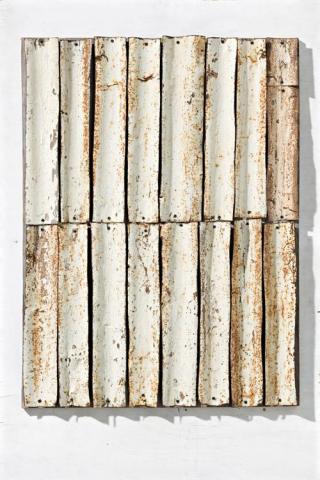IRON BARK, 1994-5
Rosalie Gascoigne
synthetic polymer paint on corrugated iron on wood
112.5 x 75.0 cm
signed, dated and inscribed verso: Rosalie Gascoigne / 1994/5 / 'IRON BARK'
Roslyn Oxley9 Gallery, Sydney (label attached verso)
Susan Norrie and Ewan McDonald, Sydney
Martin Browne Fine Art, Sydney
The Collection of Andrew Upton and Cate Blanchett, Sydney
Rosalie Gascoigne, Roslyn Oxley9 Gallery, Sydney, 23 August – 16 September 1995, cat. 12
MacDonald, V., Rosalie Gascoigne, Regaro Press, Sydney, 1998, p. 106
White Garden 1995, synthetic polymer paint on corrugated iron on wood, 177.0 x 184.0 cm in MacDonald, ibid., cat. 64 (illus.)
Steel Magnolias 1994, synthetic polymer paint on corrugated iron on wood, 104.0 x 99.0 cm in MacDonald, ibid., cat. 63 (illus.)
With her training in the formal discipline of Ikebana complementing her intuitive understanding of the nature of materials, her deep attachment to her environment and later interest in modern art, Rosalie Gascoigne remains one of Australia's most revered assemblage artists. Bespeaking a staunchness and scrupulous eye, her works are artful and refined, yet always maintain a close proximity to the outside world, powerfully evoking remembered feelings or memories in relationship to the landscape; they are 'instances of emotion recollected in tranquility' to quote a phrase of Wordsworth's which was so dear to her. And therein lies one of the great paradoxes of her art '...while she was a lover of the outdoors by the same token her work displays all the formal qualities of the studio: as bricolage, as a formal discipline of aesthetic givens, it is entirely unprovincial.'1
Evoking the ever-recurring - but never monotonous - rhythms of nature, Iron Bark, 1995, belongs to an important series of wall-based assemblages which feature corrugated iron garnered from the artist's local environment surrounding Canberra. In a similar vein to the post-painterly abstract grids of American minimalist Agnès Martin, such works serve primarily as generalisations, on the limited scale of an artwork, for the expanse of landscape. Their interest lies not in the identity of the objects used in their construction but in the quality of material - its texture, colour and shape - which corresponds to the quality of a known and loved environment. Presented here with very little intervention from the artist, heavy rippling 'corro' is, as Gascoigne appreciated, inextricably linked to the history and topography of this country; 'it is a very Australian thing. I think it's evident in itself and I would like to make it more obvious and maybe add some poetry to it.'2 Accordingly perhaps, the title of the present assemblage not only captures literally the essence of the piece 'iron on bark' but moreover alludes, in a skilful double entendre, to that iconic Australian verse by Banjo Patterson, 'The Man from Iron Bark.'
Reflecting upon her use of corrugated iron in works such as the present, Gascoigne muses 'It's only old tin but I think it's got real presence. It's beauty where you don't expect to find it...'3 Indeed, we are reminded that, like the materials themselves, beauty is a quality easily and thoughtlessly discarded; as John McDonald suggests, 'When we value things for their usefulness, we overlook a more fundamental necessity. Life is impoverished by the inability to recognise beauty in even the most humble guise.'4
1. Wedde, I., How to be Nowhere: Essays and Texts 1971-1994, Victoria University Press, Wellington, 1995, p. 179
2. Gascoigne cited in MacDonald, V., Rosalie Gascoigne, Regaro, Sydney, 1998, p. 37
3. Gascoigne cited ibid., p. 101
4. McDonald, J., 'Introduction' in MacDonald, ibid., p. 7
VERONICA ANGELATOS
